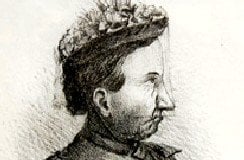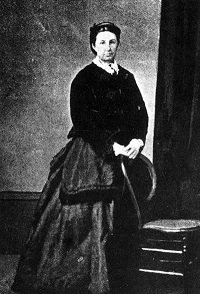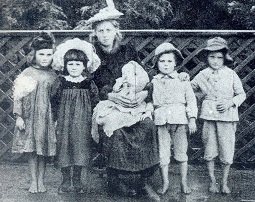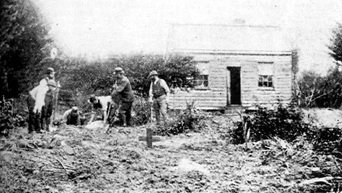Minnie Dean, New Zealand Baby Farmer

The woman who would become infamous as Minnie Dean was born on the 2nd October 1844 in Renfrewshire, Scotland . Her full name was Williamina McCulloch, but her unwieldy first name was soon shortened to Minnie. She was the fourth of eight girls, and her father was an engine driver. When she was thirteen years old her mother died of cancer, and some time after that she decided to emigrate to New Zealand. Exactly when she did that is uncertain, as the next we hear of her is when she arrived in the city of Invercargill as a young widow of around twenty-four with two small children in tow. She told the people there that she had been married to a doctor in Tasmania, and had decided to move to the city when he died. In truth, given that she gave her maiden name as her married name, it seems possible that this husband never existed and that the eldest of those two children might be why a young Scottish girl had decided to move to New Zealand in the first place.
Regardless of what her life had been before Invercargill, there she found a measure of acceptance, lodging with an old lady she referred to affectionately as Granny Kelly. She married a local man named Charles Dean in 1872, at the age of 28. Charles owned an inn out north of Invercargill, on the road between it and Te Anu. During the gold rush years the inn had prospered, but with the gold fields worked out the traffic had slowed, and in 1878 Charles was forced to turn his hand to sheep-farming. He proved to be a poor farmer, and was forced to take out a loan with his land as collateral. Still, life was not all hard. Both of Minnie’s daughters were married, while the Deans adopted a five-year old girl named Margaret in 1880. Unfortunately, even this happiness was blighted with sorrow – one of Minnie’s daughters, named Ellen, suffered a bout of post-natal depression and killed both of her children and herself.

In 1884 the land prices in New Zealand collapsed, and Charles was forced to declare himself bankrupt. Six months later he was able to discharge himself from bankrputcy, but the family lost the farm. In 1887 they moved to the small town of Winton, where Charles was able to purchase a reasonably large house for a bargain price as it had been defaulted on by a mortgagee also hit by the land price collapse. Unfortunately this rare piece of luck was soon rendered immaterial when the house burnt down. The family built a two-room cottage on the site, and Charles began raising pigs. With money tight, Minnie also had to contribute to the family finances, and this she did through child-minding.
The child-minding that Minnie did was not modern daycare, but rather was a practice known disparagingly as “baby-farming”. In return for payment, Minnie would take in and care (day and night) for unwanted babies, usually born out of wedlock but sometimes born to parents unable to take care of them. The financial arrangements varied – sometimes the parents paid her monthly, and would retrieve the children when their own situation improved. Others would pay her a lump sum to adopt the child and raise it, before returning to their lives. In a society without reliable contraception and with no social safety net, baby farming was seen by some as a necessary evil. Others, more cynical about human nature, saw the potential for abuse of the system. Infant mortality was a fact of life in those times, and while some baby farmers did indeed care for their adopted children as if they were their own, others would neglect them, often taking on far more children than they could reasonably take care of. It’s pretty clear that Minnie was, at best, one of the latter.

The death of a six-week old infant at “The Larches” (Minnie’s cottage) in 1891 prompted an inquest. While they found no evidence of wrong-doing, the judge did note the earlier death of a child in Minnie’s care in 1889, and told her that she had too many children for the size of her cottage. In Minnie’s defence, however, the court did note that the children did seem to be well-nourished. Rather than reduce the number of children in her care as the court ordered, Minnie began advertising under false names . The inquest on the six-week old child had been very public, and her own name was too infamous to use any more. The police, prompted more by the public outcry than the coroner’s findings, began keeping a file on Minnie. Perhaps significantly, there was some indication that she began inquiring into the possibility of applying for life insurance for the children in her care. In 1893 she visited Christchurch and acquired a three-week old baby, but the owner of the boarding house where she stayed was worried about the child and called the police. A detective was so struck by the poor care that the child was receiving that he immediately confiscated it, and wrote in his report that he was sure the child would have been dead before Minnie reached Dunedin. Two years later, his words would seem tragically prescient.
On the 2nd May 1895, a railway guard noticed Minnie Dean boarding his train in Winton with a baby and a hatbox. The police later identified the baby as Dorothy Carter, who had been given to Minnie by her grandmother. When Minnie left the train at Lumsden, he noticed that she no longer had the baby. Before he could stop her she had left the station, and so he reported the incident. The police took an interest, and began investigating. As their investigation later uncovered, Minnie stayed overnight in Lumsden and then took a train to Dunedin. There she had the hatbox (which was, the porters later claimed, “suspiciously heavy”) put into storage, before meeting a woman named Mrs Hornsby. She also entrusted her month old grand-daughter, Eva, into Minnie’s care. Minnie set off back home, collecting her hatbox on the way. It was noted that on her return trip she once again had no baby, but instead had acquired a wrapped parcel to go with the hatbox.

When the police inquiry into the missing baby on the train reached Milburn, word of it reached Mrs Hornsby and she came forward to tell her story. From her description the police recognised Minnie, and they soon showed up at the Larches with a search warrant, and with Mrs Hornby. She recognised Minnie, but Eva was nowhere to be found. Minnie and Charles were arrested and the search began. First they found a piece of clothing that Eva had been wearing (recognised by Mrs Hornsby), and then when they turned their attention to the garden they made a far more gruesome discovery. Buried in the soil were the corpses of both Eva and Dorothy, along with the decayed remnants of an older boy. Based on this evidence Minnie was charged with the murder of Dorothy and Eva. Charles, who it transpired had been utterly forbidden from working in the garden, was released without charge.

The trial was a national sensation. While Australia had several years earlier had two separate baby farming murder cases, [1] this was the first in New Zealand. The image of Minnie Dean and the grisly contents of her hatbox was a powerful one in the public consciousness, and miniature replicas were among the gruesome souvenirs sold outside the court. Investigators found that Dorothy Carter had died from an overdose of laudanum, a popular sedative at the time that consisted of a mixture of opium and alcohol. Eva Hornsby had been smothered. Minnie’s defence was that both deaths were accidental, as was that of the older boy (she claimed that he had drowned in 1893). She had, he lawyer claimed, concealed the deaths in order to avoid the bad publicity that she had suffered years earlier. While that defence might have held up if there had been only one death, the deaths of Eva and Dorothy so soon after they entered her care, and especially the fact that Minnie had not let Dorothy’s death prevent her from continuing on to collect Eva, undermined it in the minds of the jury. Minnie was found guilty, and sentenced to death. Over the next month and a half she wrote her own account of her life, maintaining that all the children who died in her care did so of natural causes. She maintained her innocence even as she went to the gallows on the 18th August, becoming the only woman ever hanged in New Zealand.
Naturally, Minnie’s infamy led to her becoming a mythic figure in New Zealand. Her crimes helped to spur the Infant Protection Act through parliament the following year, while parents would scare their children to bed by telling them Minnie was coming with her hatbox to take them away to her farm, where they would never be heard from again. The plant she grew in her garden over the graves, orange Montbretia, was shunned by her fellow Southlanders. Meanwhile, a story grew up that no plant at all would grow on Minnie’s grave. She became the subject of several songs, including a ballad written by Helen Henderson, who was raised on tales of Minnie, and more recently even had a metal song written about her life. In later years an inevitable attempt was made to “rehabilitate” Minnie, with Lynley Hood, for example, recasting her as the victim of a scapegoating exercise that sought to blame her for the societal ills that made her baby-farming trade necessary. In 2009 her descendants raised funds to have a tombstone placed on her unmarked grave, though peculiarly before they could do so an unofficial tombstone appeared on the grave. This mysterious monument was removed, and a more traditional gravestone put in its place a month later. Buried but not forgotten, the memory of Minnie Dean lives on.

Images via wikimedia except where noted.
[1] John and Sarah Makin, who were notable for having their own children testify against them in court, and Frances Knorr, whose death sentence was so controversial that it drove the state executioner to suicide.
